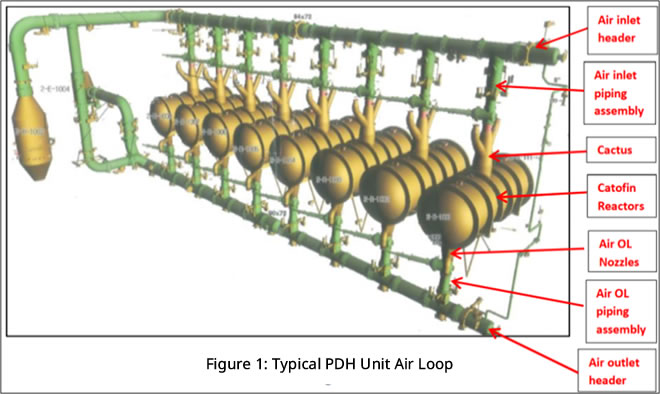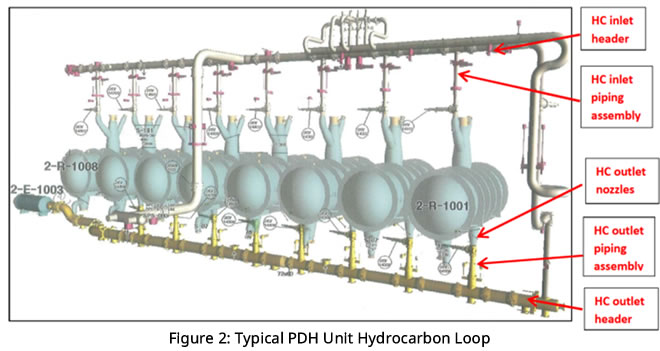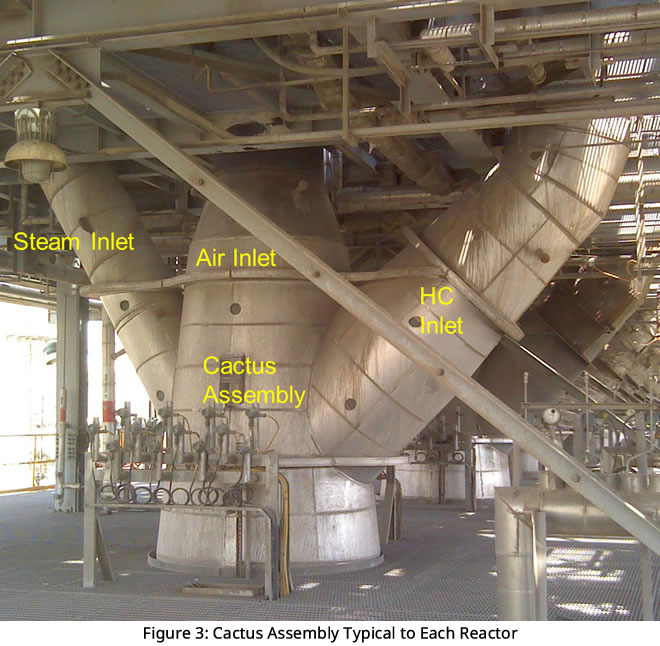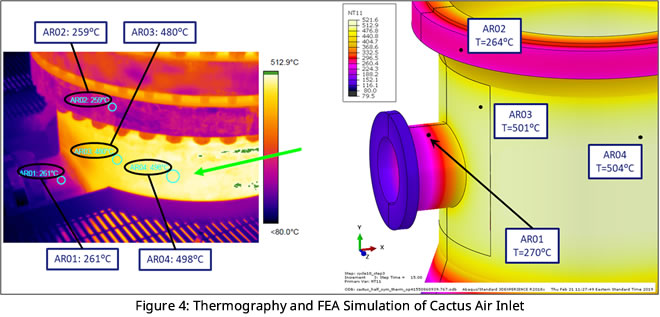Multidisciplinary Approach To Improve Reliability Of A CATOFIN Unit
…with contributions by Chuck Becht V
In this difficult era of decreased margins and rapidly changing markets, onstream reliability is critical to the success of operating facilities. Achieving high onstream reliability can be particularly challenging for complex systems like a CATOFIN® Unit. The CATOFIN® Unit pairs extremely high operating temperatures with a complex control system interaction of instrumentation, valves, compressor train, and gas turbines. The mechanical design must overcome multiple damage mechanisms (e.g. elevated temperature creep, fatigue due to thermal cycling, creep-fatigue interaction, material property degradation, etc.) The instrumentation and control system side must be strategically set up to avoid frequent spurious trips which can exacerbate the severity of the mechanical damage mechanisms. Becht has extensive experience in re-designing bad actor units and success with instituting reliability improvements for these complex systems. We utilize a multi-disciplinary approach to determine root causes and establish practical modifications for improved performance. This article focuses on our approach to address reliability issues with CATOFIN® units specifically, but the principles can be applied to other units with challenging service conditions.
The CATOFIN® licensing technology is a process for propane dehydrogenation (PDH) that is employed at numerous facilities worldwide. Licensed by Lummus Technology, it is a process for production of olefins, such as propylene (from propane) and iso-butylene (from iso-butane). This is a continuous PDH process that uses sequential cyclic operation of multiple fixed-bed reactors through automated programming to control the key phases of the process. The unit employs large diameter main piping headers for the air and hydrocarbon (HC) inlet and outlet circuits (see Figures 1 and 2), as well as components called cacti that connect to each reactor and multiple piping branches (see Figure 3). The headers operate at relatively low pressure or vacuum conditions, but relatively high process temperatures on the order of 570°C (1060°F) to 705°C (1300°F), depending on the region of the system. The headers are hot-walled configuration, type 321H SS and employ numerous bellows type expansion joints due to the significant thermal growth at these temperatures. Regions of the cacti are typically cold-walled (refractory lined) and transition to hot-walled in some designs, with 310H SS material transitioning to low chrome on the HC and steam branches.


The service environment includes high velocity flow (vibration), high temperature creep, thermal cycling and HC coke formation. Numerous damage mechanisms are relevant including, creep, fatigue, refractory and metal erosion, and sigma phase embrittlement of both 321H and 310S stainless steel components that are originally specified for these units. Due to the extensive number of header expansion joints, mechanical reliability issues with these components alone are inevitable. Unfortunately, these issues can become frequent after only a few years of operation. The piping and support systems were originally designed to accommodate steady operating conditions based on fundamental ASME Code piping calculations and system piping stress analysis. However, supplemental detailed engineering analysis and selection of proven details resistant to elevated temperature cyclic operation were generally lacking in the original designs.
To establish the root cause of failures Becht utilizes a broad team of subject matter experts and link practical experience with supporting engineering analysis. The process includes a comprehensive review of operating procedures and controls, inspection and failure histories, and instituted repairs. Finite element and computational fluid dynamics simulations can be used to provide an additional level of detailed analysis and identification of local failure modes that many times were not performed as part of original design (see Figures 3 and 4). Comparative analysis can be performed to highlight design improvements and provides insight regarding structural performance.


For the reactor inlet region of the CATOFIN® hot piping, including the cacti, temperature cycles are accumulated from the process operation on the order of every 30 minutes, as well as thermal cycles from start-up/shutdown during normal operation and Emergency Shutdowns (ESDs). The main HC and air headers are affected only by system heat-up and cooldown cycles, including ESDs. Since the operation is at very low positive or vacuum pressures, temperature changes and associated thermal stresses are the most important consideration affecting damage accumulation. For the pressure boundary, this is particularly important for the non-refractory lined components, which includes the hot-walled headers and the air inlet region of the reactor cacti. This is because these regions will respond more rapidly to temperature changes and are more likely to develop thermal stress. The important operating parameters that affect thermal fatigue are the frequency and severity of the temperature fluctuations. The severity is governed by the rate of heating or cooling and the overall magnitude of temperature change (DT) during the event.
In our experience, an interaction of an embrittling mechanism (Sigma phase), thermal gradients (from ESD and/or poor insulation practices), local stress concentrations due to poor original design details, and excessive cycling from repeated ESD’s can cumulate in an unnaturally aged piping system compared to other process units in refineries and petrochemical plants. Coke formation in expansion joint liners can be a significant issue. Although it does not typically lead to unplanned outages, extensive repeated repairs during outages are usually required and many times set the critical path of the shutdown.
Since unplanned shutdowns cause additional cooldown and heat-up thermal stress cycles for the hot piping systems, they have an adverse effect on the life of hot piping components. Unplanned shutdowns are often a result of unit trips due to issues with instrumentation, gas turbines, compressor train, or air preheaters. Additionally, these unplanned shutdowns often require rapid cool down of at least one of the hot piping headers potentially causing accelerated damage.
Design improvements employed typically involve component modifications, materials and welding modifications, and insulation detailing based on proven experience and engineering analysis. These modifications will significantly improve resistance to damage and correspondingly increase component life. Becht has successfully employed this approach on multiple occasions and is available to assist you with your challenges.



